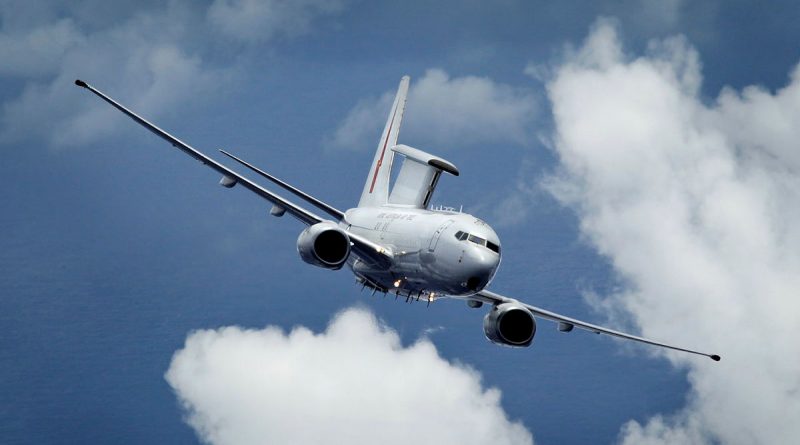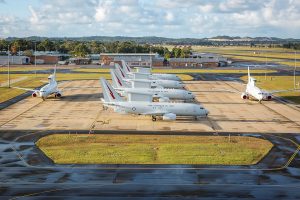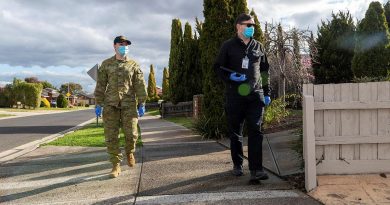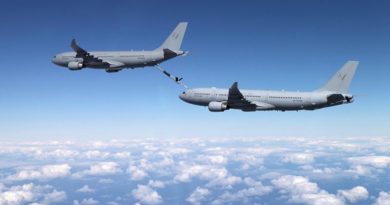Top 10 Iconic RAAF Aircraft – 6: E-7A Wedgetail
Share the post "Top 10 Iconic RAAF Aircraft – 6: E-7A Wedgetail"

As the Royal Australian Air Force celebrated its Centenary on 31 March 2021, they compiled their Top 10 most iconic aircraft of the past 100 years.
CAPTION: A No. 2 Squadron E-7A Wedgetail soars through the clouds on a training sortie. Photo by Corporal Shannon McCarthy.
Counting backwards – at number 6 is the radar superstar in the sky: the E-7A Wedgetail.
As Australia’s first early warning and control aircraft in service, the Wedgetail is easily recognised by its game-changing MESA radar (AKA the ‘surfboard’) at the top of the fuselage.
More than 600 hours of wind tunnel testing was required to perfect the aerodynamic design resulting in the addition of two ventral fins.
The RAAF Wedgetail crew is able to monitor a 4million square kilometre area and coordinate more than 60 aircraft over a single 10-hour mission.
The E-7A Wedgetail provides Australia with one of the most advanced air battlespace management capabilities in the world.
Based at RAAF Base Williamtown, the RAAF’s six E-7A Wedgetails significantly improve the effectiveness of the Australian Defence Force.
They are capable of communicating with other aircraft and providing air control from the sky, and can cover four million square kilometres during a single 10-hour mission.
Final Operational Capability for the E-7A Wedgetail platform was announced in May 2015.
It has participated in Exercises Bersama Lima, Cope North, Red Flag and Pitch Black and served with distinction in the Middle East on Operation Okra as well as on North Korean sanctions-monitoring duty out of Japan.
The E-7A Wedgetail is based on a Boeing 737-700, with the addition of an advanced Australian-designed Multi-Role Electronically Scanned Array (MESA) radar, and 10 state-of-the-art mission crew consoles which can track airborne and maritime targets simultaneously.
It is a highly advanced aircraft, providing an airborne early warning and control platform that can gather information from a wide variety of sources, analyse it, and distribute it to other assets.
The E-7A Wedgetail can:
- control the tactical battle space;
- provide direction for assets in the air, at sea and on land; and
- support aircraft such as tankers and intelligence platforms.
Manufactured by Boeing and based on the Boeing 737 next generation design roughly similar to the 737-700ER. The first two were built and tested in Seattle, Washington, while following E-7A Wedgetails were modified by Boeing Australia.
Australia initially ordered four aircraft with options for an additional three, eventually six being delivered.
Originally scheduled to start delivery to the RAAF in 2006, delays related to integrating the radar, sensor and Electronic Support Measure systems resulted in delayed delivery of the first aircraft to November 2009.
The sixth and final A-7E was delivered on the 5 June 2012.
No. 2 Squadron based at Williamtown NSW operate all E-7A’s with a permanent detachment to RAAF base Tindal NT.
CAPTION: All six E-7A Wedgetails from No. 2 Squadron on the tarmac at RAAF Base Williamtown. Photo by Corporal Craig Barrett.
Initial Operation Capability (IOC) was achieved in November 2012 and the first operational sortie being involved in the search for missing Malaysian Airlines flight MH-370 off the Western Australia coast.
After operating over Iraq in support of coalition forces against Islamic State, the E-7A achieved final operating capacity in May 2015.
During continued operations in the Middle East Area of Operation (MEAO) in 2016 the E-7a achieved 100 percent mission success rate.
Specifications:
- Crew – pilot, co-pilot and ten airborne electronics analysts and mission specialists (space for an additional two)
- Engines – two CFM56-7 turbofans creating 27,300 lb thrust each.
- 33.6 meters long
- 12.6 meters high
- 34.3 meter wingspan
- Maximum speed 955km/h
- Cruise speed 760km/h.
- 7040km range
- 41,000ft ceiling
Equipment:
- Multi-role electronically scanned array (MESA) radar with range in excess of 400km
- Electronic warfare self-protection measures including directed infra-red counter-measures, chaff and flares
- Communication systems including HF, VHF, UHF, Link-11, Link-16, UHF SATCOM and ICS
- 10 mission consoles
Operation:
Originally designed to Australian government specification, the E-7A has been selected by the Turkish Air Force (four E-7T Peace Eagle), the Republic of Korea Air Force (four Peace Eye) and the United Kingdom (five ordered, first delivery expected in 2023 (Wedgetail AEW1).
Other countries interested in future purchases include Italy (14), United Arab Emirates, Qatar (3).
RAAF’s Top 10 Iconic Aircraft from its first 100 Years:
- 10: F/A-18A and F/A-18B ‘classic’ Hornet
- 9: S.E.5A
- 8: Avro Lancaster
- 7: PBY Catalina
- 6: E-7A Wedgetail
- 5: ???
- 4: ???
- 3: ???
- 2: ???
- 1: ???
.
.

.
.
Share the post "Top 10 Iconic RAAF Aircraft – 6: E-7A Wedgetail"






